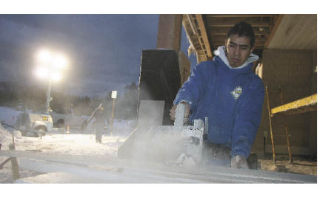For years, Snoqualmie Ridge was the fastest selling master planned community in Washington.
While the Ridge continues to grow, this season’s shaky economy and financial slump mean that new construction of the community’s 1,850-home second phase is moving at a slower pace.
“There is no area, anywhere, that’s not affected by what the economy is doing,” said Dave Dorothy, Quadrant Homes’ general manager for Snoqualmie Ridge development. “It’s definitely affected sales here, as it has anywhere. It’s unprecedented.”
A “perfect storm” of economic bad news has left many potential home buyers hunkering down and waiting to see what comes next, he said.
“The uncertainty of times is causing them to hold back.”
The Ridge’s two phases were originally slated to reach full build-out by 2011 or 2012. That estimate will likely slide into the future because of the current economic situation.
Quadrant typically builds homes as they are sold.
“We’ve cut back on what we’re actually developing, and will be cutting back on what we originally planned on developing next year,” Dorothy said.
Quadrant is cautiously optimistic for the future, but Dorothy said the situation might not improve significantly for at least a year.
“We’re probably just taking a breather,” said Donya Gregson, Interim Finance Director for the city of Snoqualmie. There will still be slow growth, but definitely not what the city has been used to, she added.
Home sales and permitting are an important part of the city of Snoqualmie’s budget, which took a $12 million cut for 2009.
The city took a conservative stance on revenues for the coming year, making moderate budget cuts, taking advantage of attrition to cut staffing, and holding off on new capital expansions.
Gregson said Snoqualmie typically lags behind national economic trends by several months. She estimated that home permitting activity may ramp up again next year, but not fully rebound until 2010.
Snoqualmie Ridge has historically been one of Quadrant’s best-performing communities.
The Ridge’s original phase, designed under a partnership of Quadrant, the city of Snoqualmie and King County, saw its first tenant move in 10 years ago, and is now a handful of homes away from full build-out.
The Ridge’s second phase, established in 2004, began construction in 2005. Phase two consists of three parcels on the north, south, and west sides of phase one, and includes land set aside for several parks and two sites for future schools in the Snoqualmie Valley School District. The development is currently entitled for 1,850 homes, but if the school district sells one of the school sites back to Quadrant, 2,000 new homes will be allowed. The sale of a second school would allow 2,150 homes. Those parcels currently remain school property.
Phase two is roughly 40 percent built out, and about a third of its homes are occupied.
The deal that created the Ridge set aside many parks as well as thousands of acres to be protected from development, north and south of the Ridge and in the vicinity of Snoqualmie Falls.
Part of the Ridge’s appeal is its proximity to nature, green spaces, and great views. A system of trails connect Ridge residents with wetlands and parks, other neighborhoods and the commercial center.
“A lot of people back up to these green spaces,” Dorothy said.
Some areas of the phase two map have yet to be drawn in west of the parkway, surrounding a new 16-acre community park with three ballfields.
The economic slowdown may also change the date that big new park will open. Construction of the park is tied to the building of a certain number of houses.
Once finished, the two phases of the Ridge will be a unified place, connected by trails and centering on a commercial heart where people can work, shop and play.
“We see it as really one community,” Dorothy said.



